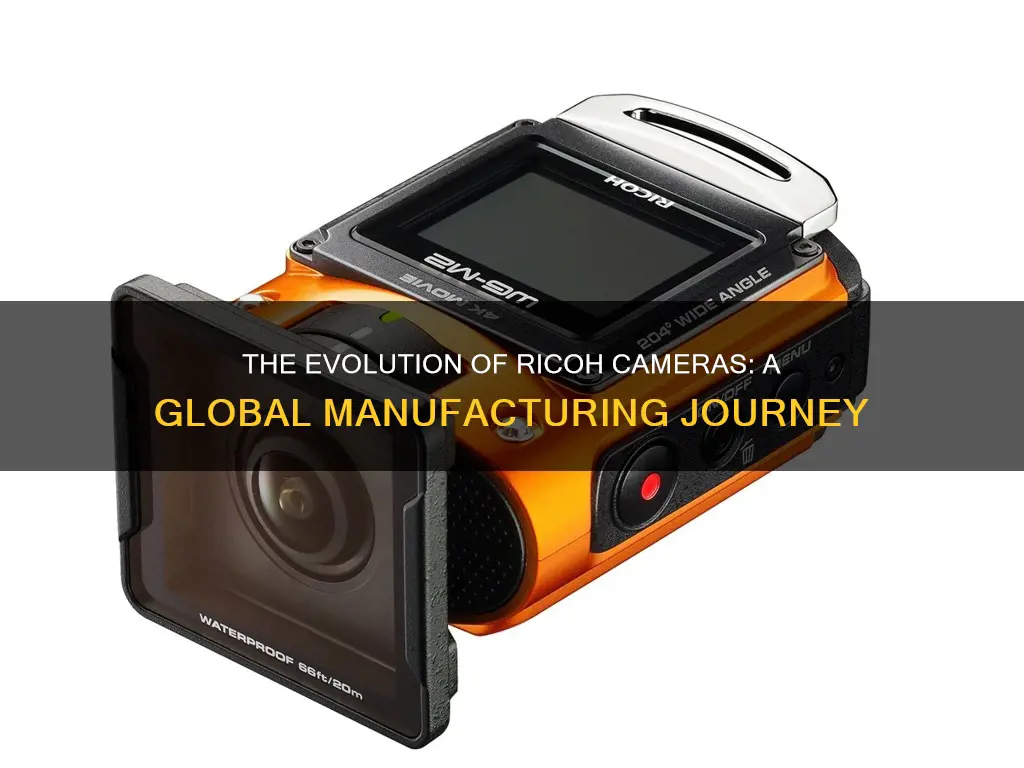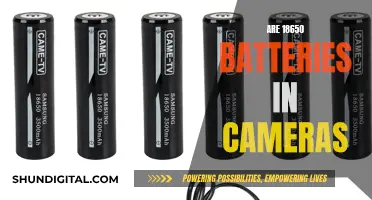
Ricoh is a Japanese company that produces digital cameras, lenses, and office equipment. It was founded in 1936 as Riken Sensitized Paper, a commercial division of the Institute of Physical and Chemical Research. In 1938, the company was renamed Riken Optical Industries, Ltd. and began manufacturing cameras and binoculars. Today, Ricoh has a global presence with regional headquarters in the Americas, Europe, Asia/Pacific, and Japan. While the company has shifted its camera sales strategy in Japan to direct-to-consumer sales and workshop-like manufacturing, its distribution structure in North America remains unchanged. Ricoh cameras are produced in various locations, including Japan, Vietnam, and the Philippines.
| Characteristics | Values |
|---|---|
| Company Name | Ricoh Company, Ltd. |
| Type of Company | Japanese multinational imaging and electronics company |
| Date Founded | 6 February 1936 |
| Founder | Commercial division of the Institute of Physical and Chemical Research (Riken) |
| Headquarters | Ōta, Tokyo, Japan |
| Regional Headquarters | Americas (Exton, PA, USA), Europe (Amstelveen, the Netherlands and London, U.K.), Asia/Pacific (Singapore) |
| No. of Subsidiaries | 272 (72 national and 200 overseas) |
| Products | Cameras, lenses, office equipment (printers, photocopiers, fax machines), projectors, Software as a Service (SaaS) document management applications |
| Manufacturing Locations | Vietnam, Philippines, Japan |
What You'll Learn

Ricoh is a Japanese company
The company's early products included sensitized paper, cameras, and binoculars, with its first camera, the Riken No.1, released in 1939. In 1953, Ricoh introduced Japan's first belt-conveyor production system for camera manufacturing, achieving a production capacity of 10,000 units per month. This mass production system made the Ricohflex Model III camera affordable for consumers, contributing to its popularity in Japan.
Over the years, Ricoh has diversified its product offerings and expanded globally. In the 1960s and 1970s, the company produced wristwatches and briefly partnered with the Hamilton Watch Company to create the Ricoh Hamilton Electric watch. Ricoh also supplied electronic components for video game consoles, including CPUs and sound chips for the Nintendo Entertainment System and Super Nintendo Entertainment System.
In 2006, Ricoh moved its headquarters to the 25-story Ricoh Building in the Ginza area of Chūō, Tokyo. The company has regional headquarters in the Americas, Europe, Asia/Pacific, and Japan, with a global presence in nearly 180 countries.
Ricoh's recent acquisitions include purchasing naming rights to stadiums and partnering with other technology companies. In 2003, they bought the naming rights to the CNE Coliseum in Toronto, now known as Coca-Cola Coliseum. Two years later, Ricoh acquired the naming rights to the stadium/entertainment complex of Coventry City Football Club, now called the Ricoh Arena. In 2019, Ricoh announced a partnership with Cisco Systems.
Ricoh has also made strategic acquisitions to expand its business areas. In 2004, they acquired Hitachi Printing Solutions, creating Ricoh Printing Systems. In 2017, Ricoh acquired Pentax Imaging, adding to its existing digital camera range. This acquisition led to a change in the company name to Ricoh Imaging Company Ltd. in 2013.
While Ricoh has shifted its sales strategy in Japan towards direct-to-consumer sales and "workshop-like" manufacturing, the company continues to have a strong global presence in the camera market.
Arecont Cameras: Where Are They Manufactured?
You may want to see also

Ricoh's headquarters are in Tokyo
Ricoh is a Japanese company that produces digital cameras, lenses, and office equipment. Its headquarters are located in Ōta, Tokyo, Japan, with regional headquarters in the Americas, Europe, China, and the Asia-Pacific.
The company was founded on February 6, 1936, as Riken Sensitized Paper, a division of the now-defunct commercial division of the Institute of Physical and Chemical Research (Riken). Ricoh's origins date back to a decision by the Institute of Physical and Chemical Research to commercialize its research by setting up a business venture, Rikagaku Kogyo.
Over the years, Ricoh has expanded its business and product offerings through acquisitions and partnerships. It has also established research and development centers, as well as manufacturing plants in various countries, including Japan, the United States, the United Kingdom, Vietnam, and the Philippines.
Ricoh's history in Tokyo goes back to its founding days. The Institute of Physical and Chemical Research, from which Ricoh emerged, was based in Bunkyo-ku, Tokyo. In 1938, the head office of Riken Optical Industries, Ltd., a predecessor of Ricoh, was located in Ginza, Tokyo. The Oji Plant, the main factory of Riken Optical Industries, was also located in Tokyo and manufactured sensitized paper, cameras, and binoculars.
In 1941, the subsidiary Asahi Musen Kogyo, which produced cameras and optical products, was based in Magome, Tokyo. This location is where Ricoh's current headquarters are situated.
In 2006, Ricoh's headquarters moved to the 25-story Ricoh Building in the Ginza area of Chūō, Tokyo. This move brought the company to the heart of one of the city's most prestigious and bustling districts, known for its upscale shopping, dining, and entertainment options.
Tokyo, as the headquarters location, plays a significant role in Ricoh's operations and decision-making. It serves as the central hub for the company's regional and global activities, providing strategic direction and coordinating efforts across its various business units and international subsidiaries.
Understanding the Camera Raw Defringe Filter
You may want to see also

Ricoh's first camera was the Ricohflex III
Ricoh is a Japanese company that produces digital cameras, lenses, and office equipment. The company was founded in 1936 as Riken Sensitized Paper Co Ltd, a division of the Riken research institute, which has existed since 1917. The Ricohflex III, released in September 1950, was Ricoh's first camera. It was the world's first mass-produced twin-lens reflex camera.
The Ricohflex III was the successor to the Ricohflex B, a TLR camera produced before World War II. The Ricohflex III featured synchronous focusing, with geared focusing rings around both the taking and viewing lenses. It was equipped with a pair of Ricoh Anastigmat 1:3.5 f=80mm lenses with AR coating. The camera had a simple, modular design and a low-cost box structure. Due to the high production volume of over 10,000 units per month, Riken used a conveyor belt assembly line.
The Ricohflex III was the first of several geared-lens Ricohflex models, which were very successful in the domestic and export markets. The popularity of these cameras sparked a "TLR boom" in Japan during the 1950s. The Ricohflex series included several subsequent models, such as the Ricohflex IIIB, Ricohflex IV, and Ricohflex VI, each offering improvements and variations on the original design.
Hive Camera: Battery Operated or Not?
You may want to see also

Ricoh's Vietnam factory has been open since 1996
Ricoh is a Japanese company that produces digital cameras, lenses, and office equipment. Its headquarters are located in Ōta, Tokyo, Japan, and it has regional headquarters in the Americas, Europe, Asia/Pacific, and Japan.
Ricoh's Vietnam factory, located near Hanoi, has been operational since 1996. The factory is run by a wholly-owned subsidiary called Ricoh Imaging Products Vietnam and covers a total area of 35,000 square meters, with two production buildings of around 7,000 square meters each. The factory employs 998 people, with a focus on providing a comfortable and equitable environment for female employees. As a result, the workforce is about 75% female, and over half of the managers are women.
The Vietnam factory manufactures the GR III camera and 94 varieties of lenses, including almost all K-mount lenses. While some parts of Pentax cameras are made there, the cameras themselves are produced at a separate plant in the Philippines.
Ricoh's history dates back to the Riken research institute, founded in 1917. In 1927, the institute decided to commercialize its research by setting up Rikagaku Kogyo, which later became Riken Kankoshi Co., Ltd.—the predecessor of Ricoh. Over the years, Ricoh has grown and diversified its business, becoming a leading pioneer in automatic camera technologies and office equipment.
Olympus OM-D: The Scene Mode King
You may want to see also

Ricoh's GR III range is affected by the move to online-only sales
Ricoh is a Japanese company that produces digital cameras, lenses, and office equipment. In 2022, the company announced that it would be adopting a full digital sales system for its Pentax and Ricoh GR brands in Japan, moving from mass-produced models to artisan products sold only online. This means that the Ricoh GR III range of premium compact cameras will no longer be available in camera stores.
The GR III is a pocketable camera with a large APS-C sensor, great image quality, and image stabilization. It has a fast startup time, a snap focus feature, built-in memory, and a macro mode. However, it also has some drawbacks, such as poor video quality and the lack of a tilt screen.
The move to online-only sales for the GR III range is part of Ricoh's strategy to strengthen its online and offline contact with customers, build a co-creation community, and offer better options for its loyal fan base to try out products. By giving up on existing retailers and moving to internet-only operations through its own sales site, Ricoh expects to better grasp the demand within the marketplace and implement customer feedback more regularly in its manufacturing process.
Charging Your SLS Camera: A Step-by-Step Guide
You may want to see also







